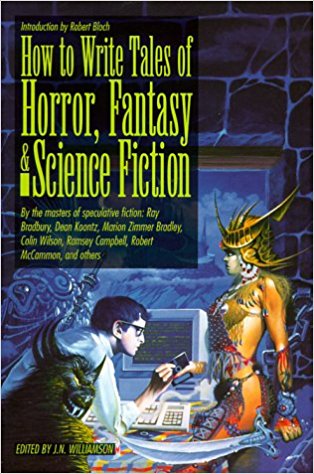
Although this volume was published in 1987 (and a paperback version came out in 1991), I found the essays on writing enlightening. Most of the essays in this Writer’Digest Book publication focus on the writing process and getting published. But, the essays are also a window into the individual writers and their methods of writing. Copies of this book are available online for a pittance. But there’s a lot here to enjoy and learn from. If you’re a fan of Horror, Fantasy, or Science Fiction you’ll find How to Write Tales of Horror, Fantasy & Science Fiction fascinating. GRADE: A
TABLE OF CONTENTS:
Editor’s Foreword – Certain of what We Do Not See.
Introduction – How to Write Horribly for Fun and Profit by Robert Bloch.
Chapter 1: Run Fast Stand Still by Ray Bradbury,
Chapter 2: Plotting as Your Power Source by Williamson,
Chapter 3: Reality and the Waking Nightmare by Mort Castle,
Chapter 4: One View by Steve Rasnic Tem,
Chapter 5: Oh Just Call me Cuthbert by Thomas Millstead,
Chapter 6: Involving Your Reader by William F. Nolan,
Chapter 7: Freedom of Originality by James Kisner,
Chapter 8: Creating Fantasy Folk by Ardath Mayhar,
Chapter 9: Keeping the Reader on Edge by Dean R. Koontz,
Chapter 10: Stepping Into the Shadows by Charle L. Grant,
Chapter 11: Innocence and Terror by Robert R. McCammon,
Chapter 12: World Building in Fantasy by Marion Zimmer Bradley,
Chapter 13: Sword and Sorcery by Darrell Schwitzer,
Chapter 14: Science Fiction by Michael A.Banks,
Chapter 15: Researching Science Fantasy by Sharon Baker,
Chapter 16: Avoiding What’s Been Done to Death by Ramsey Campbell,
Chapter 17: Why Novels of Fear Must Do More than Frighten by Dean R. Koontz,
Chapter 18: The Supernatural, Naturally! by J. N. Williamson,
Chapter 19: Sexist Stereotypes by Jeannette Hopper,
Chapter 20: They Laughed when I Howled at the Moon, by Richard Christian Matheson,
Chapter 21: The Psychology of Horror and Fantasy by Katherine Ramsland,
Chapter 22: Fantasy and Faculty X by Colin Wilson,
Chapter 23: A “Do” List for Getting Your Literary Agent by Mary T. Williamson,
Chapter 24: Putting It on the Editor’s Desk by Alan Rodgers,
Chapter 25: The Mechanics and Mystique of Submitting Your Novel by Patrick LoBrutto,
Chapter 26: Darkness Absolute aThe Standards of Excellence in Horror Fiction by Douglas Winter,
Chapter 27: Overview of Horror, SF and Fantasy A Long-range Market Study by Janet Fox.
Contributors to This Book
The Top Ten “Favorites” List–in Horror, Fantasy & SF (Novels and Short Stories)
Recommended Reading Library in Horror, Fantasy and Science Fiction
Index
Fascinating, George. I’m a fan of Horror, Fantasy and Science Fiction though, frankly, I don’t read in the genres as much as I’d like to.
Prashant, HOW TO WRITE TALES HORROR, FANTASY & SCIENCE FICTION will generate enthusiasm to read more of these genres! The RECOMMENDED reading lists are helpful, too.
Good list of authors.
Jeff, everyone who was anyone in these genres seemed to have contributed to this volume.
I’ve managed not to pick this up over the decades, but the cast of writers involved suggests I should correct that.
Todd, inexpensive copies are available online. Well worth a look!
Judging from the chapter titles, the slant here is on the dark side of the genres. I prefer hard SF and “quest” fantasy.
Rick, Horror was a hot genre when this book was published. The number of articles about the Dark Side reflect that.
Thanks for the post, George. Just bought a copy at Ebay. Looking forward to it.
Elgin, I think you’ll enjoy HOW TO WRITE TALES OF HORROR, FANTASY & SCIENCE FICTION. There are plenty of fun essays in this book!